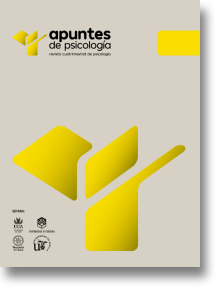Influence of gender, country, BMI, Instagram use, food moralization and body image on body dysmorphia in young adults from Spain and Venezuela.
DOI:
https://doi.org/10.55414/zvhj6619Keywords:
body dysmorphia, food moralization, body image, young adultsAbstract
Body Dysmorphia Disorder (BDD) is characterized by an excessive concern with physical appearance, which has been of interest to the scientific community in recent years. Different variables have been found to influence BDD; therefore, the aim of the present research was to determine the direct and indirect effect of gender, country, age, body mass index, Instagram use, food moralization and body image on dysmorphia; comparing Spanish and Venezuelan nationality. A path analysis was performed with the total sample (208 participants), finding that the variables that
directly or indirectly influence are sex, body mass index, food-related guilt, country and body image; also, people who present body dysmorphia behaviors tend to be women, people with high BMI, greater dissonance between their body image and perceived body image, and tend to feel food-related guilt. In addition, in an indirect way, Venezuelans presented greater body dysmorphia behaviors. We conclude the relevance of these variables on BDD and recommend considering these findings when planning intervention strategies and prevention policies.
Downloads
References
Anxiety and Depression Association of America (2019). Body dysmorphic disorder (BDD). https://adaa.org/understandinganxiety/body-dysmorphic-disorder
American Psychiatric Association (2014). Manual diagnóstico y estadístico de los trastornos mentales, 5ª Ed. (DSM-5). Editorial Médica Panamericana.
Ahmadpanah, M., Arji, M., Arji, J., Haghighi, M., Jahangard, L., Sadeghi-Bahmani, D. y Brand S. (2019). Sociocultural attitudes towards appearance, self-esteem and symptoms of body-dysmorphic disorders among young adults. International Journal of Environmental Research and Public Health, 16(21), 4236. https://doi.org/10.3390/ijerph16214236
Arslan, M., Yabancı Ayhan, N., Sarıyer, E.T., Çolak, H. y Çevik, E. (2022). The effect of bigorexia nervosa on eating attitudes and physical activity: A study on university students. International Journal of Clinical Practice, 6325860. https://doi.org/10.1155/2022/6325860
Cáceres, N. (2018). Los manuales de cocina y urbanidad, un elemento clave para la moralización de las costumbres en Quito durante el siglo XIX y principios del siglo XX. História e Cultura, 7(2), 186-202. https://doi.org/10.18223/hiscult.v7i2.2686
Calderón-Mazzotti, I. y Cruz-Mendoza, E.D. (2022). Narrativas sobre dismorfia corporal en TikTok. Aiken. Revista de Ciencias Sociales y de la Salud, 2(2), 31-46. https://eamdq.com.ar/ojs/index.php/aiken/article/view/35
Camacho-Vidal, P., Díaz-López, A. y Sabariego- García, J.A. (2023). Relación entre el uso de Instagram y la imagen corporal de los adolescentes. Apuntes de Psicología, 41(2), 117-122. https://doi.org/10.55414/ap.v41i2.1537
Castro-López, R., Molero, D., Cachón-Zagalaz, J. y Zagalaz-Sánchez, M.L. (2014). Factores de la personalidad y
fisicoculturismo: Indicadores asociados a la vigorexia. Revista de Psicología del Deporte, 23(2), 295-300. https://archives.rpd-online.com/article/download/v23-n2-castro-lopez-molero-etal/1369-5102-2-PB.pdf
Chacón, G., Angelucci, L. y Fernández, T. (2015). Influencia de la insatisfacción con la imagen corporal, índice de masa corporal, autoconcepto físico, y sexo sobre las conductas alimentarias de riesgo en estudiantes universitario. Revista de Psicología, 34(1), 109-135. http://saber.ucv.ve/ojs/index.php/rev_ps/article/view/12449
Contois, E.J.H. (2015). Guilt-free and sinfully delicious: A contemporary theology of weight loss dieting. Fat Studies, 4(2). 112-126. https://doi.org/10.1080/21604851.2015.1015925
De Garine, I. (1972). The socio‐cultural aspects of nutrition. Ecology of Food and Nutrition, 1(2), 143-163. https://doi.org/10.1080/03670244.1972.9990282
França, K., Roccia, M.G., Castillo, D., ALHarbi, M., Tchernev, G., Chokoeva, A. y Fioranelli, M. (2017). Body dysmorphic disorder: history and curiosities. Wiener Medizinische Wochenschrift, 167, 5-7. https://doi.org/10.1007/s10354-017-0544-8
Gardner, R.M., Stark, K., Jackson, N. y Friedman, B.N. (1999). Development and validation of two new scales for assessment of boby-image. Perceptual and Motor Skills, 89(3), 981-993. https://doi.org/10.2466/pms.1999.89.3.981
Giraldo-O’Meara, M. y Belloch, A. (2017). El trastorno dismórfico corporal: Un problema infra-diagnosticado. Revista de Psicopatología y Psicología Clínica, 22(1), 69-84. https://doi.org/10.5944/rppc.vol.22.num.1.2017.17929
Imaz-Roncero, C., Ruiz-Lázaro, P.M. y Pérez-Hornero, J. (2022). Enfoques utilizados en la prevención secundaria de los trastornos de la conducta alimentaria: revisión de la evidencia y la efectividad. Nutrición Hospitalaria, 39(2), 97-111. http://dx.doi.org/10.20960/nh.04185
Keery, H., Van den Berg, P. y Thompson, J.K. (2004). An evaluation of the tripartite influence model of body dissatisfaction and eating disturbance with adolescent girls. Body Image, 1(3), 237-251. https://doi.org/10.1016/j.bodyim.2004.03.001
Krebs, G., Fernández de la Cruz, L. y Mataix-Cols, D. (2017). Recent advances in understanding and managing body dysmorphic disorder. BMJ. Evidence Based Mental Health, 20(3), 71-75. https://doi.org/10.1136/eb-2017-102702
León, O.G. y Montero, I. (2003). Métodos de investigación en psicología y educación (3ª Ed.). McGraw-Hill.
Lee, E., Lee, J.A., Moon, J.H. y Sung, Y. (2015). Pictures speak louder than words: Motivations for using Instagram. Cyberpsychology, Behavior, and Social Networking, 18(9), 552-556. https://doi.org/10.1089/cyber.2015.0157
Meneses-Montero, M. y Moncada-Jiménez, J. (2008). Imagen corporal percibida e imagen corporal deseada en estudiantes universitarios costarricenses. Revista Iberoamericana de Psicología del Ejercicio y el Deporte, 3(1), 13-30. https://www.riped-online.com/articles/imagen-corporal-percibida-e-imagen-corporaldeseada-en-estudiantes-universitarios-costarricenses.pdf
Monterrosa, E.C., Frongillo, E.A., Drewnowski, A., de Pee, S. y Vandevijvere, S. (2020). Sociocultural influences on food choices and implications for sustainable healthy diets. Food and Nutrition Bulletin, 41(2), 59-73. https://doi.org/10.1177/037957212097587
Morín, G. y Palmese, G. (2021). Influencia del autoconcepto, motivo de uso, edad y sexo sobre el uso de la red social instagram (tesis de Grado). Universidad Católica Andrés Bello, Venezuela.
Muyor, J.M. (2013). Exercise intensity and validity of the ratings of perceived exertion (Borg and OMNI Scales) in an indoor cycling session. Journal of Human Kinetics, 39, 93-101. https://johk.pl/wp-content/uploads/2023/03/10.2478_hukin-2013-0072.pdf
Oliveira-Gonçalves, V. y Parra-Martínez, J. (2014). Imagen corporal y percepción de la influencia de los medios de comunicación: Diferencias de género en una muestra de adolescentes. Inter-Ação, 39(3), 461-478. https://doi.org/10.5216/ia.v39i3.27535
Opara I. y Santos N.A. (2019). Conceptual framework exploring social media, eating disorders, and body dissatisfaction among latina adolescents. Hispanic Journal of Behavioral Sciences, 41(3), 363-377. https://doi.org/10.1177/0739986319860844
Pedreschi Caballero, R.J. y Nieto Lara, O.M. (2021). Las redes sociales como estrategia de marketing en las pequeñas y medianas empresas del distrito de Aguadulce, provincia de Coclé, Panamá. Visión Antataura, 5(2), 115-131. https://revistas.up.ac.pa/index.php/antataura/article/view/2526
Puertas, D.G. (2020). Influencia del uso de instagram sobre la conducta alimentaria y trastornos emocionales. Revisión sistemática. Revista Española de Comunicación en Salud, 11(2), 244-254. https://doi.org/10.20318/recs.2020/5223
Ramón-Arbués, E., Martínez-Abadía, B., Granada-López, J.M., Echániz-Serrano, E., Pellicer-García, B., Juárez-
Vela, R., Guerrero-Portillo, S. y Saéz-Guinoa, M. (2019). Conducta alimentaria y su relación con el estrés, la ansiedad, la depresión y el insomnio en estudiantes universitarios. Nutrición Hospitalaria, 36(6), 1339-1345. http://dx.doi.org/10.20960/nh.02641
Rizwan, B., Zaki, M., Javaid, S., Jabeen, Z., Mehmood, M., Riaz, M., Maqbool, L. y Omar, H. (2022). Increase in body dysmorphia and eating disorders among adolescents due to social media. Pakistan BioMedical Journal, 5(3), 148-152. https://doi.org/10.54393/pbmj.v5i3.205
Rodgers, R.F., Slater, A., Gordon, C.S., McLean, S.A., Jarman, H.K. y Paxton, S.J. (2020). A biopsychosocial model of social media use and body image concerns, disordered eating, and muscle-building behaviors among adolescent girls and boys. Journal of Youth and Adolescence, 49(3), 399-409. https://doi.org/10.1007/s10964-019-01190-0m
Rodríguez-Campayo, M.A., Beato-Fernández, L., Rodríguez-Cano, T. y Martínez-Sánchez, F. (2003). Adaptación española de la escala de evaluación de la imagen corporal de Gardner en pacientes con trastornos de la conducta alimentaria. Actas Españolas de Psiquiatría, 31(2), 59-64. https://actaspsiquiatria.es/index.php/actas/article/view/957
Rozin, P., Bauer, R., y Catanese, D. (2003). Food and life, pleasure and worry, among American college students. Gender differences and regional similarities. Journal of Personality and Social Psychology, 85(1), 132-141. https://doi.org/10.1037/0022-3514.85.1.132
Sanchez-Castro, A.E., Cook-del Águila, L., Yacila-Huaman, G.A., Tejada-Caminiti, R.A., Reyes-Bossio, M.A. y Mayta-Tristán, P. (2019). Prevalencia de sintomatología de dismorfia muscular y factores asociados en estudiantes universitarios varones. Revista Mexicana de Trastornos Alimentarios, 10(2), 185-195. https://doi.org/10.22201/fesi.20071523e.2019.2.558
Saunders, J. y Eaton, A. (2018). Snaps, selfies, and shares: how three popular social media platforms contribute to the sociocultural model of disordered eating among young women. Cyberpsychology, Behavior, and Social Networking, 21(6), 343-354. https://doi.org/10.1089/cyber.2017.0713
Sharp, G., Hutchinson A.D., Prichard, I. y Carlene, W. (2013). Validity and reliability of the Food-Life Questionnaire. Short form. Appetite, 70, 112-118. https://doi.org/10.1016/j.appet.2013.07.001
Slade, P.D. (1994). What is body image? Behaviour Research and Therapy, 32(5), 497-502. https://doi.org/10.1016/0005-7967(94)90136-8
Strobel, C., Kolbeck, D., Mayer, I., Perras, M. y Wunderer, E. (2020) Muscle dysmorphia: the compulsive pursuit of a muscular body. Characteristics, prevalence, causes, treatment, prevention and nutritional implications. Ernahrungs Umschau, 67(12), 214-221. https://www.ernaehrungs-umschau.de/fileadmin/Ernaehrungs-Umschau/pdfs/pdf_2020/12_20/EU12_2020_PR_Muskel_Eng.pdf
Villegas-Moreno, M. y Londoño-Pérez, C. (2021). Modelo predictivo de insatisfacción con la imagen corporal. En C. Londoño-Pérez y M. Peña-Sarmiento (Eds.), Perspectivas de investigación psicológica: aportes a la comprensión e intervención de problemas sociales (pp. 133-157). Editorial Universidad Católica de Colombia. https://www.doi.org/10.14718/9789585133808.2021.8
Veale, D., Gledhill, L.J., Christodoulou, P. y Hodsoll, J. (2016). Body dysmorphic disorder in different settings: A systematic review and estimated weighted prevalence. Body Image, 18, 168-186. https://doi.org/10.1016/j.bodyim.2016.07.003
Wick, M.R. y Keel, P.K. (2020). Posting edited photos of the self: Increasing eating disorder risk or harmless behavior? International Journal of Eating Disorders, 53(6), 864-872. https://doi.org/10.1002/eat.23263
Downloads
Published
Issue
Section
License
Copyright (c) 2024 Apuntes de Psicología

This work is licensed under a Creative Commons Attribution-NonCommercial-NoDerivatives 4.0 International License.


















